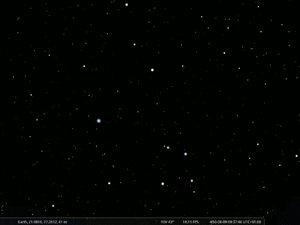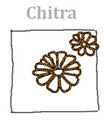Chitra: Difference between revisions
No edit summary |
No edit summary |
||
| (One intermediate revision by the same user not shown) | |||
| Line 9: | Line 9: | ||
* Chitra |
* Chitra |
||
* Tvarshtra |
* Tvarshtra |
||
===Origin of Constellation=== |
|||
Chitra means "the bright one" and is clearly a name for a single star-asterism. In the Indian Vedic coordinate system, the sidereal zodiac, this star marks the point 180° at the ecliptic. As precession continues, the ecliptic latitudes remain always the same, so that a star directly at the ecliptic (like [[Spica]]) at any historical epoch marked and will mark the invisible ecliptic. |
Chitra means "the bright one" and is clearly a name for a single star-asterism. In the Indian Vedic coordinate system, the sidereal zodiac, this star marks the point 180° at the ecliptic. As precession continues, the ecliptic latitudes remain always the same, so that a star directly at the ecliptic (like [[Spica]]) at any historical epoch marked and will mark the invisible ecliptic. |
||
The temple depictions characterise this nakshatra by a point which refers to the important anchor of their frame of reference. |
The temple depictions characterise this nakshatra by a point which refers to the important anchor of their frame of reference. |
||
=== |
====Stars within the Constellation Area==== |
||
{| class="wikitable sortable mw-collapsible" |
|||
|+ |
|||
|- |
|||
!id |
|||
!Label |
|||
!IAU design. |
|||
!description |
|||
!Vmag |
|||
|- |
|||
|1 |
|||
|Spica |
|||
|HIP 65474 |
|||
|Constellation lines (Vertex) |
|||
|0.97 |
|||
|- |
|||
|2 |
|||
|Apamvatsa |
|||
|HIP 66006 |
|||
|Constellation lines (Vertex) |
|||
| 4.69 |
|||
|} |
|||
===Transfer and Transformation of the Constellation=== |
===Transfer and Transformation of the Constellation=== |
||
<gallery> |
|||
File:Chitra nakshatras in Temple draw+lbl 4ase.jpg|Chitra 10th century CE |
|||
File:Nakshatra temple magDraw lbl.jpg|Display of all 28th nakshatra in silver arch with candles in Tirupperunthurai (Athmanathaswamy temple) near Aranthangi, India, 10th century CE. (SMH 2025). |
|||
File:Nakshatras in Temple draw+lbl 4ase.jpg|Display of all 28th nakshatra in a door frame in Tirupperunthurai (Athmanathaswamy temple) near Aranthangi, India, 10th century CE. (SMH 2025). |
|||
File:Tibet nakshatra 12.png|Chitra Tibetean |
|||
File:14 Chitra draw.png|Chitra as reconstructed by Jones (1720). |
|||
</gallery> |
|||
==Mythology== |
==Mythology== |
||
Latest revision as of 17:18, 14 December 2025
Citrā (चित्रा), "the bright one", is an Indian name, used by the Indian Vedic tradition. Most of these names are roughly 3000 years old. They pre-date Hinduism but were taken over by it.
Etymology and History
Name Variants
- Chitra
- Tvarshtra
Origin of Constellation
Chitra means "the bright one" and is clearly a name for a single star-asterism. In the Indian Vedic coordinate system, the sidereal zodiac, this star marks the point 180° at the ecliptic. As precession continues, the ecliptic latitudes remain always the same, so that a star directly at the ecliptic (like Spica) at any historical epoch marked and will mark the invisible ecliptic.
The temple depictions characterise this nakshatra by a point which refers to the important anchor of their frame of reference.
Stars within the Constellation Area
| id | Label | IAU design. | description | Vmag |
|---|---|---|---|---|
| 1 | Spica | HIP 65474 | Constellation lines (Vertex) | 0.97 |
| 2 | Apamvatsa | HIP 66006 | Constellation lines (Vertex) | 4.69 |
Transfer and Transformation of the Constellation
Mythology
mnemonic tales and cultural significance
Weblinks
References
- References (general)










